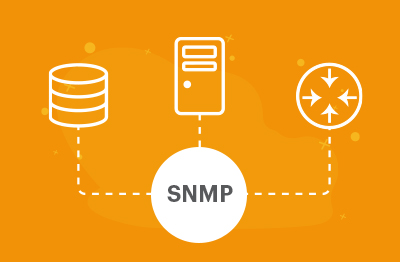SNMP
What is SNMP?
Simple Network Management Protocol (SNMP) is an Internet Standard protocol for collecting and organizing information about managed devices on IP networks and for modifying that information to change device behavior.
SNMP exposes management data in the form of variables on the managed systems organized in a management information base (MIB), which describe the system status and configuration. These variables can then be remotely queried (and, in some circumstances, manipulated) by managing applications.
Three significant versions of SNMP have been developed and deployed. V1 is the original version of the protocol. More recent versions, V2c and V3, feature improvements in performance, flexibility, and security.
What is SNMP used for?
One of the biggest advantages of SNMP is that it is an open standard protocol. A number of standard MIBs have been defined that allow monitoring tools to obtain metrics of interest from any device, irrespective of model and vendor, that support the standard MIBs. For example, MIB-II is a standard MIB that allows network equipment to expose information about the number of network interfaces they support and the traffic in and out of each interface (besides a number of other statistics). A monitoring system can poll any device that supports MIB-II, auto discover the interfaces on the device, and monitor bandwidth usage on each interface.
There are a number of standard SNMP MIBs – for example, the Host Resources MIB for monitoring resource usage on any system and the Fiber Channel MIB to monitor any fiber channel network switch. Vendors provide enterprise specific MIBs that expose additional details about their devices. For example, to monitor the CPU usage of a Cisco router, a monitoring tool must support the Cisco proprietary CPU MIB. Likewise, Cisco routers support a NetFlow MIB. A monitoring tool that supports this MIB can get information about the top sources and destinations that are communicating through the router.
SNMP is mainly used for:
How does SNMP work?
SNMP works with a network management system to relay configuration changes and status information to IT administrators. The NMS provides administrators with a centralized interface that they can use to issue batch commands and view automated alerts.
SNMP uses a mix of pull and push communications between the NMS and network devices to collect and disseminate information. In most instances, SNMP functions within a synchronous model. The SNMP manager initiates device communication, and the agent software responds.
Components of SNMP
An SNMP-managed network includes four core components, which are as follows:
Each component plays a critical role in the collection and transmission of information from nodes to the NMS. That said, the NMS is foundational to the success of your SNMP monitoring strategy. When choosing an NMS, ensure that your platform can accommodate the number and type of hardware included in your network.
What is SNMP monitoring?
SNMP monitoring provides your organization with a standardized method for gathering information about networking equipment. Your IT personnel can use these insights to ensure your network is running at peak efficiency and performance.



